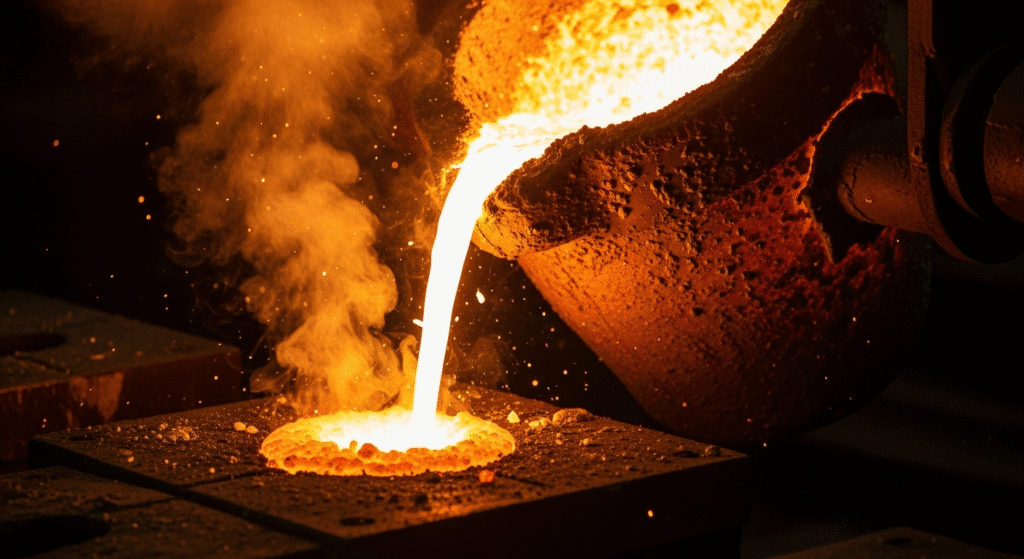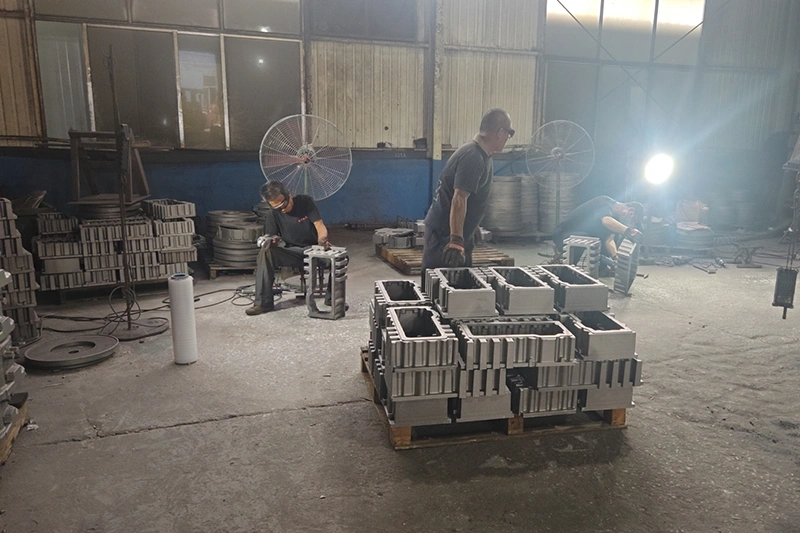Steel melts between 1370°C and 1540°C (2500°F to 2800°F), depending on its composition. Unlike pure iron which melts at exactly 1538°C, steel transitions from solid to liquid over a temperature range because it’s an alloy of iron, carbon, and other elements.
The carbon content is the biggest factor affecting steel’s melting point. Higher carbon content means lower melting temperatures—a high-carbon steel with 1% carbon starts melting around 1425°C, while low-carbon mild steel doesn’t begin melting until about 1500°C.

Carbon steels melt between 1425°C and 1540°C, with the exact temperature determined primarily by carbon content. Low-carbon steels (like mild steel with 0.2% carbon) melt at the higher end near 1500-1525°C, while high-carbon steels (around 1% carbon) begin melting at the lower end around 1425°C.
This happens because carbon disrupts iron’s crystal structure and forms a eutectic mixture that melts at lower temperatures. For every 0.1% increase in carbon content, the melting point drops by roughly 10-15°C.
Most carbon steels you’ll encounter follow this pattern:
The presence of small amounts of manganese, silicon, and sulfur in commercial carbon steels has minimal impact on melting temperature. Heat treatment doesn’t change the melting point either—whether your steel is annealed or hardened, it melts at the same temperature based on its composition.
Stainless steels generally melt between 1370°C and 1530°C, with specific ranges varying significantly by grade. The chromium content (minimum 10.5%) combined with nickel, molybdenum, and other additions creates different melting behaviors than plain carbon steel.
Most stainless steels actually have slightly lower melting points than carbon steel because nickel and other alloying elements depress the melting temperature. The melting behavior depends entirely on which type of stainless steel you’re working with.
Austenitic grades like 304 and 316 have the lowest melting ranges among stainless steels, typically 1375-1450°C. Type 304 stainless steel (18% chromium, 8% nickel) starts melting around 1400°C and is completely liquid by 1455°C.
The high nickel content is responsible for this lower melting point. Nickel melts at 1453°C, significantly lower than iron’s 1538°C, and when alloyed with iron it forms a solid solution that melts at intermediate temperatures.
Type 316 stainless steel melts at an even lower range of 1375-1400°C due to its higher nickel content and the addition of 2-3% molybdenum. This makes austenitic grades easier to weld but limits their use in extreme high-temperature applications.
Ferritic stainless steels melt at higher temperatures than austenitic grades, typically 1450-1510°C. Type 430 (16-17% chromium, no nickel) begins melting around 1425°C and becomes fully liquid by 1510°C.
The absence of nickel keeps the melting point closer to plain iron. While chromium has a very high melting point (1890°C), at the concentrations used in ferritic steel it doesn’t raise the melting point—it simply maintains it near carbon steel levels.
These steels retain better strength at high temperatures than austenitic grades. Their higher melting range makes them suitable for exhaust systems and other applications where temperature resistance matters.
Martensitic stainless steels show the widest variation in melting ranges, from 1370-1530°C depending on carbon content. Type 410 (12% chromium, 0.1% carbon) melts similarly to ferritic grades at 1480-1530°C.
High-carbon martensitic grades tell a different story. Type 440C (17% chromium, 1% carbon) starts melting as low as 1370°C due to its high carbon content, despite having more chromium than many other grades.
This demonstrates how carbon’s effect on melting point overrides the influence of chromium. The combination creates a wide melting range—440C doesn’t fully liquefy until around 1480°C, giving it a 110°C melting range compared to just 50°C for low-carbon grades.
Tool steels typically melt between 1420°C and 1540°C, though their complex compositions create unusually wide melting ranges. These steels contain 0.5-2% carbon plus significant amounts of chromium, tungsten, molybdenum, and vanadium, creating a challenging melting behavior.
The high carbon content means tool steels start melting at relatively low temperatures—around 1400-1420°C for the iron-carbon matrix. But the carbide-forming elements create extremely stable compounds that don’t melt until much higher temperatures.
Take D2 tool steel (1.5% carbon, 12% chromium) as an example. It begins melting at 1420°C but isn’t completely liquid until 1540°C—a 120°C range. The chromium carbides scattered throughout the steel remain solid long after the surrounding matrix has melted.
High-speed steels like M2 show even more extreme behavior. The steel matrix melts around 1400-1425°C, but tungsten carbides within it can remain solid well above 1500°C. This makes tool steels notoriously difficult to cast or weld without specialized high-temperature equipment.
| Steel Grade | Composition | Melting Range (°C) | Key Factor |
|---|---|---|---|
| Low-Carbon Steel (1020) | ~0.2% C, 99% Fe | 1500-1525 | Near pure iron |
| High-Carbon Steel (1095) | ~0.95% C, 98-99% Fe | 1425-1500 | Carbon lowers solidus |
| Stainless 304 (Austenitic) | 18% Cr, 8% Ni, 0.08% C | 1400-1450 | Nickel depresses melting point |
| Stainless 430 (Ferritic) | 16% Cr, <0.1% C, no Ni | 1450-1510 | High iron content |
| Stainless 440C (Martensitic) | 17% Cr, 1.0% C | 1370-1480 | High carbon creates wide range |
| Tool Steel D2 | 1.5% C, 12% Cr, Mo, V | 1420-1540 | Carbides extend range |
| High-Speed Steel M2 | 0.8% C, 6% W, 5% Mo | 1400-1425* | *Matrix only; carbides remain solid |

